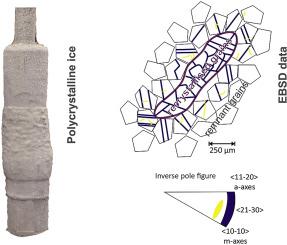当前位置:
X-MOL 学术
›
J. Struct. Geol.
›
论文详情
Our official English website, www.x-mol.net, welcomes your feedback! (Note: you will need to create a separate account there.)
The role of kink boundaries in the deformation and recrystallisation of polycrystalline ice
Journal of Structural Geology ( IF 3.1 ) Pub Date : 2020-07-01 , DOI: 10.1016/j.jsg.2020.104010 Meike Seidemann , David J. Prior , Narayana Golding , William B. Durham , Kat Lilly , Matthew J. Vaughan
Journal of Structural Geology ( IF 3.1 ) Pub Date : 2020-07-01 , DOI: 10.1016/j.jsg.2020.104010 Meike Seidemann , David J. Prior , Narayana Golding , William B. Durham , Kat Lilly , Matthew J. Vaughan

|
Abstract Kinking is a common process in materials with a strong visco-plastic anisotropy but its impact on the plastic deformation and recrystallisation of crystal aggregates is still poorly constrained. Here, kinking is studied via constant stress experiments on polycrystalline ice under relatively low temperature (240 K) and high differential stress (13.3 MPa and 2.7 MPa, with 50 MPa confining pressure). EBSD data analysis shows that samples comprise large and small grains, interpreted as remnant and recrystallised. Boundary trace analyses and misorientation data of kinked remnant grains reveal that kink boundaries are best characterised with rotation axes within the basal plane of the ice crystal. Inferred slip directions within the basal plane are variable and include , and intermediate directions. Shorter grain boundaries with rotation axes outside the basal plane surround kink boundaries and indicate that non-basal dislocations or ripplocations play a role in accommodating local kink deformation. More kink boundaries per grain and a larger boundary misorientation are generally found in remnant grains in the high-stress sample. At an aggregate level, kinking as a key facilitator for the dynamic recrystallisation process is represented by many straight grain boundaries with basal rotation axes in the remnant and recrystallised grain population. The statistically preferred slip direction within the basal plane is , consistent with coupled slip on two crystallographic a-axes with uneven contributions.
中文翻译:

扭结边界在多晶冰变形和再结晶中的作用
摘要 扭结是具有强粘塑性各向异性的材料的常见过程,但其对晶体聚集体的塑性变形和再结晶的影响仍然缺乏约束。在这里,通过在相对低温 (240 K) 和高差应力(13.3 MPa 和 2.7 MPa,50 MPa 围压)下对多晶冰进行恒应力实验研究扭结。EBSD 数据分析显示样品包含大晶粒和小晶粒,解释为残余和再结晶。扭结残余颗粒的边界轨迹分析和错误取向数据表明,扭结边界最好用冰晶基面内的旋转轴来表征。基面内推断的滑动方向是可变的,包括 、 和中间方向。旋转轴在基面外的较短晶界围绕扭结边界,表明非基底位错或裂变在调节局部扭结变形中起作用。通常在高应力样品的残余晶粒中发现每个晶粒更多的扭结边界和更大的边界错误。在总体水平上,作为动态再结晶过程的关键促进因素的扭结由残余和再结晶晶粒群中具有基本旋转轴的许多直晶界表示。基面内的统计首选滑移方向是 ,与两个晶体学 a 轴上的耦合滑移一致,具有不均匀的贡献。
更新日期:2020-07-01
中文翻译:

扭结边界在多晶冰变形和再结晶中的作用
摘要 扭结是具有强粘塑性各向异性的材料的常见过程,但其对晶体聚集体的塑性变形和再结晶的影响仍然缺乏约束。在这里,通过在相对低温 (240 K) 和高差应力(13.3 MPa 和 2.7 MPa,50 MPa 围压)下对多晶冰进行恒应力实验研究扭结。EBSD 数据分析显示样品包含大晶粒和小晶粒,解释为残余和再结晶。扭结残余颗粒的边界轨迹分析和错误取向数据表明,扭结边界最好用冰晶基面内的旋转轴来表征。基面内推断的滑动方向是可变的,包括 、 和中间方向。旋转轴在基面外的较短晶界围绕扭结边界,表明非基底位错或裂变在调节局部扭结变形中起作用。通常在高应力样品的残余晶粒中发现每个晶粒更多的扭结边界和更大的边界错误。在总体水平上,作为动态再结晶过程的关键促进因素的扭结由残余和再结晶晶粒群中具有基本旋转轴的许多直晶界表示。基面内的统计首选滑移方向是 ,与两个晶体学 a 轴上的耦合滑移一致,具有不均匀的贡献。



























 京公网安备 11010802027423号
京公网安备 11010802027423号